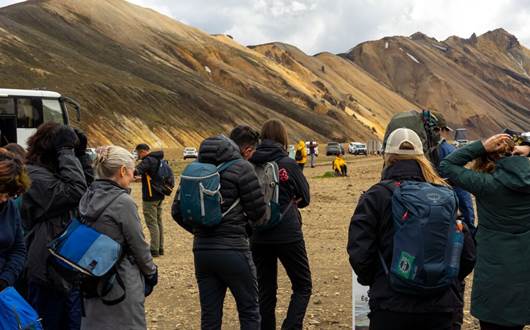
What to Wear in Iceland: All Seasons and Occasions Guide
Iceland’s epic sights come with epic weather—smart clothing choices will make all the difference. You only need to learn a few basics!
The weather in Iceland is so unique that it deserves special mention. Iceland is one of the few countries where you can experience all the seasons in one day. It changes so quickly that Icelanders even joke about it: "Don't like the weather? Just wait 5 minutes!”
The most distinct element of Icelandic weather is undoubtedly the wind. The fact that the Icelandic language has 156 words to describe it says something about its importance. From logn (calm wind) and gola (gentle breeze) to rok (gale) and fárviðri (storm), Icelandic wind is truly something to experience! Learn more about Iceland's weather nuances, seasons, and monthly temperatures in our detailed overview.
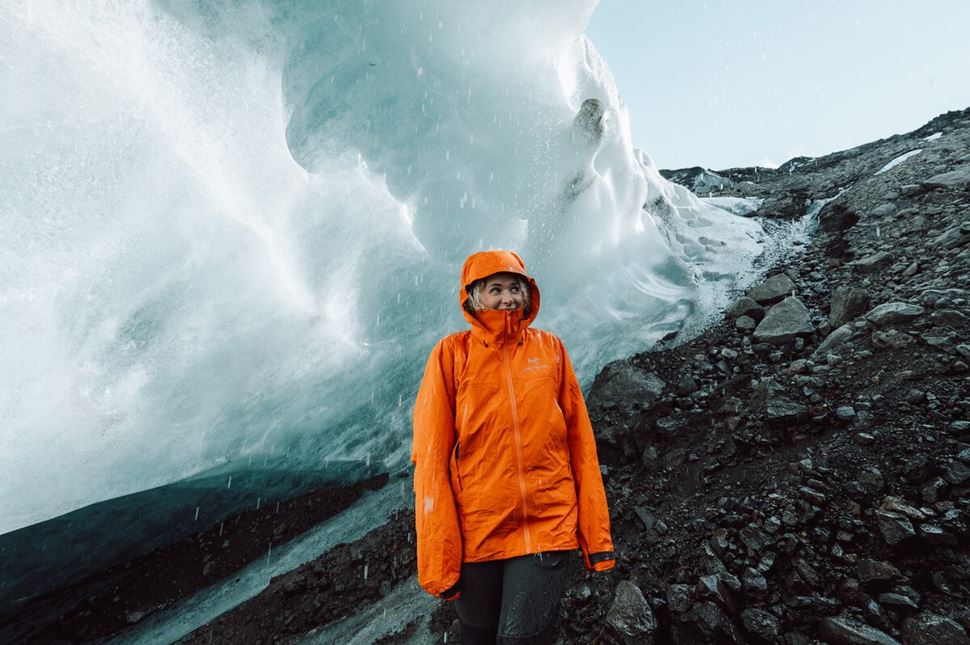
From glaciers to the coast, Iceland’s weather can surprise you—keep your jacket on hand! Photo by: Gunnar Gaukur Guthmundsson.
The climate in Iceland is divided into two main types: a milder oceanic near the coast and a colder tundra-like climate in the highlands. For a country so close to the Arctic Circle, Iceland’s weather is surprisingly moderate. This is because of warm ocean currents, like the North Atlantic Currents, which heat up the air.
In summer, daytime temperatures average around 11°C (52°F), and the highest reach up to 15°C (59°F) on sunny days. Winters are colder, with average daytime temperatures around 0°C (32°F) and the coldest days dropping to the lowest of -10°C (14°F). Yearly averages sit between 0°C and 4°C (32–39°F). The weather changes a lot between seasons, keeping tourists and locals guessing year-round.
Iceland is a land of extremes, and seasons reflect its unique character. While there are technically four seasons, spring and autumn often seem like extensions of the two main periods due to the ever-changing weather. Summer (late May to early September) is the high season for travel, with nearly 24 hours of daylight. Winter (late November to early March) sees plenty of snowfall, and strong winds often make the actual temperature feel much colder.
Rain is common year-round but peaks in October. For the best combination of weather, daylight, and activities, late May to mid-September is usually the best time to visit Iceland. Keep in mind Iceland’s seasons are defined as much by wind and rain as by temperature.

Seasons, temperature, and climate. Source: timeanddate.com
Local weather is full of surprises, but it’s rarely extremely cold or hot. Iceland winter temperature averages -2 to 3°C (28-37°F), with frequent snow storms and ice-covered roads. As spring arrives, temperatures climb to 1-7°C (34-45°F), though the wind often picks up. Summer is the warmest time in Iceland, when the thermometers reach 7-14°C (45-57°F), with long and bright days, but quick rain showers are common. Autumn cools it down again, with highs of 11°C (52°F) dropping to 6°C (43°F) as storms become more frequent. Rain peaks in October and March, while January and February bring the heaviest snowfall of all months in Iceland.
From late May to August, Iceland’s summer temperatures average around 10°C (50°F), but the wind often makes it feel about 10 degrees cooler. On the hottest days, it can reach even 20°C (68°F), though that’s less common. The summer weather is unpredictable, with drizzle, sun, and wind often switching throughout the day. On average, there are 10-12 days of rain each month, but it’s usually light and doesn’t last all day. Iceland in summer is a unique experience, with nearly 21 hours of daylight thanks to the Midnight Sun. Until mid-July, it barely gets dark, perfect for exploring non-stop along the iconic Ring Road or venturing through scenic routes like the Golden Circle Loop or Silver Circle Expedition.
Traditionally, Icelanders only recognize summer and winter, with September seen as late summer and November as early winter. Internationally, autumn in Iceland is considered to be from September to November. This midseason marks significant changes, as the weather influence for the Northern Lights makes a big difference as Iceland aurora season begins and nights get longer. Over the months, daytime temperatures quickly drop to 5°C (41°F) in October and 0°C (34°F) in November. Rain and wind storms become more frequent, with around 13 rainy days each month. You may expect the first snow in October, especially in northern regions and higher elevations.
Strong winds and icy conditions are common in Iceland in winter, with the landscape shifting between pristine white and muddy patches. Average winter temperatures in Iceland range from -2°C (28°F) to 3°C (37°F), though the biting wind makes it feel much colder. The Westfjords and highlands often experience the coldest climate, frequently below -5°C (23°F). During the Iceland snow season, the island's glaciers freeze, creating stable ice caves for exploring. Higher elevations and northern areas see more consistent snow, while milder regions may have slush or rain. Additionally, the aurora borealis become the most popular weather phenomenon to see because of the long nights.
Spring in Iceland, from March to May, is a midseason of dramatic transitions. March often feels like winter, with average daytime temperatures around 1°C (33°F), frequent snow, and icy paths, especially in the north. Wildlife returns to life, with puffins in Iceland starting to breed and live their birdly lives on the island’s shores in April. By May, average daytime temperatures rise to 7°C (45°F), bringing more sunshine and greener landscapes. Spring weather remains unpredictable, with wet, windy days alternating with clear, sunny periods. Daylight increases dramatically, from 10 hours in March to 20 hours in May, offering plenty of time for exploration.
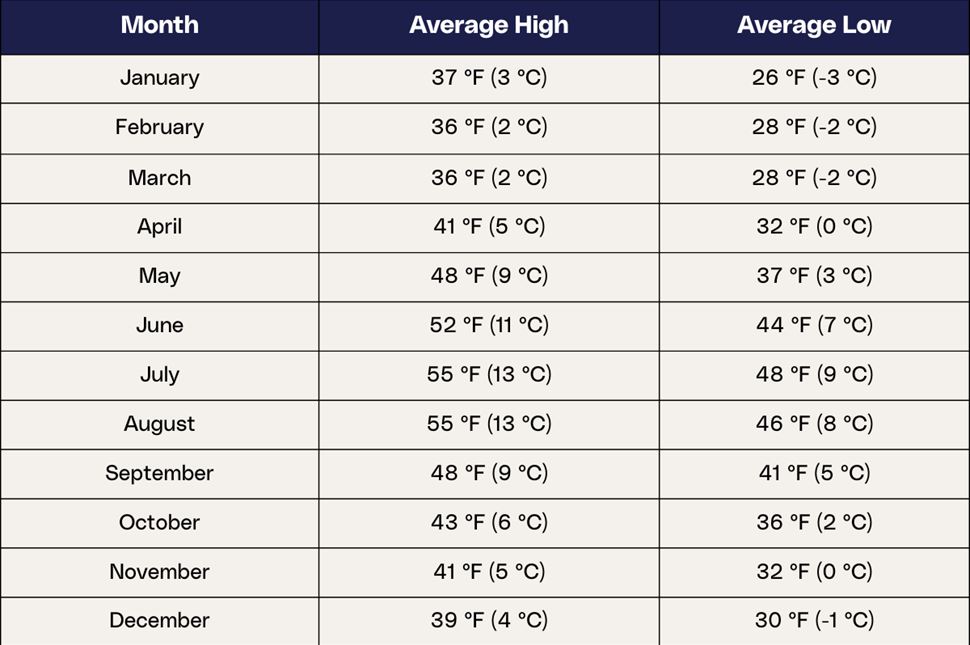
The average temperatures in Iceland by month (Reykjavik). Source: holiday-weather.com
If you expected subarctic temperatures, you might be surprised—Iceland isn’t as cold as its name suggests. During the coldest months of January and February, highs average 2°C (36°F) and lows drop to -2°C to -3°C (26–28°F). The warmest months in Iceland are July and August, with highs around 13°C (55°F) and lows near 8°C (46°F). The shoulder seasons, spring and fall, show the most contrasts, with highs ranging from 2°C (36°F) to 9°C (48°F). However, the local weather also depends on regional climate, elevation, and proximity to the coast, meaning each region can feel quite different even within the same month.
January in Iceland is the coldest and windiest month, with temperatures ranging from -3 to 3°C (26 to 37°F) in Reykjavik and dipping as low as -15°C (5°F) in the east and north. Winds average 26 km/h (16 mph) but can exceed 50 km/h (31 mph) in coastal and highland areas. Precipitation averages 50 mm (2 inches) over 14 days, mostly as snow, though rain occurs in milder southern regions. Northern areas like Akureyri often see over 50 cm (20 inches) of snow. Blizzards are common, reducing visibility. With just 4-6 daylight hours, January is ideal for Northern Lights spotting.
» Tip: With the sun low on the horizon, even during the short daylight hours, glare can be intense. Sunglasses are surprisingly useful for reducing eye strain while driving or exploring.
» The most popular tour in January is: “Into the Glacier” Ice Cave Tour
» Travel Guide to Iceland in January
February's climate is slightly wetter than January, with the first hints of lengthening days. The average temperature in Iceland in February ranges from -2°C (29°F) to 2°C (36°F). This might not seem extreme, but the steady winds at around 25 km/h (15.5 mph) can make it feel colder. Inland areas are often covered in snow, while southern regions like Vík see more rain. Precipitation averages 83 mm (3.3 inches) over 13 days, mostly as snow but with occasional rainfall. Daylight increases from 7 hours at the start of the month to 10 hours by the end, but skies remain mostly cloudy about 76% of the time, making sunny days rare.
» Tip: In towns and near popular sites, paths often freeze over. Use ice cleats or simple crampons for shoes to avoid slipping—worth investing in for safe walking.
» The most popular tour in February is: Crystal Ice Cave Tour With Super Jeep Ride
» Travel Guide to Iceland in February
The first spring month still feels mostly like winter, with a hint of change. The climate in Iceland in March is not too cold, with temperatures between -2°C (28°F) and 2°C (36°F). By late March, the highs reach around 4.4°C (40°F). Winds average 22.5 km/h (14 mph) but can feel stronger in open areas. This is one of the wettest months, with about 14 days of precipitation, falling as snow or rain, depending on the region. Daylight grows from 10 hours early in the month to over 13 hours by its end, though skies remain cloudy around 68% of the time.
» Tip: Be cautious opening car doors during high winds. Sudden gusts can rip them open or cause damage, a common issue locals are well aware of.
» The most popular tour in March is: Skaftafell Glacier Hike with Ice Cave Tour
» Travel Guide to Iceland in March
April in Iceland feels like the first real taste of spring, though winter’s presence is still noticeable in many areas. Temperatures in Iceland in April vary from 2°C (35°F) to 7°C (44°F) in the south, while in Reykjavík the average is between 0°C (32°F) and 5°C (41°F). This month is less windy than March. Wind speeds are usually around 20 km/h (13 mph) but can be stronger near the coast. There is less snow in April but more rain, with wet weather on about 13 days throughout the month. Daylight increases fast, giving you 13 hours at the start and up to 16 by month’s end—finishing the aurora season.
» Tip: With melting snow and spring rains, hiking paths, especially in rural areas, can get muddy. Waterproof boots are a must.
» The most popular tour in April is: Whale Watching Tour From Reykjavík
» Travel Guide to Iceland in April
May in Iceland feels like spring is in full swing, with a warmer climate and much more daylight. Average temperatures are well above freezing, reaching from 3°C (37°F) to 9°C (48°F) in the capital region. Rain is still quite frequent, with about 21 wet days adding up to 4.4 cm (1.7 inches). Snow is rare, but higher areas might still have a little left. The days grow dramatically longer, starting with 16 hours of daylight and stretching to nearly 21 by the end of the month. Wind speeds average around 20 km/h (13 mph), similar to April.
» Tip: Expect rain in May, and even if it may not last the whole day, a waterproof jacket and pants are a must.
» The most popular tour in May is: Puffin Watching Tour from Reykjavík
» Travel Guide to Iceland in May
June is the first official summer month in Iceland. Average daily temperatures range from 7 to 11°C (45 to 52°F), creating perfect weather for exploring. While you can expect some rainy days, wind speeds are slower at 13.6 km/h (8.3 mph). June starts with about 21 hours of daylight, increasing to nearly 24 hours by mid-month, as the Midnight Sun keeps Iceland bright around the clock. Still, about 60% of the month tends to be cloudy. Rainfall is lighter than in May, with about 40 mm (1.6 inches) spread over 9 to 11 days. While not considered dry, it’s less wet than in earlier months.
» Tip: Take with you a sleep mask or book accommodations with blackout curtains. The constant daylight can make it tricky to sleep at night!
» The most popular tour in June is: Landmannalaugar Hiking Day Tour
» Travel Guide to Iceland in June
The weather in July in Iceland is the warmest and driest of the year. It’s also the least windy month, with speeds around 13 km/h (8 mph). Temperatures range from 9°C (48°F) at night to 13°C (55°F) during the day, sometimes a few degrees higher. The rainfall is minimal, averaging only 50 mm (2 inches) over about 10 days, increasing slightly toward the end of the month. There are 21 hours of daylight early in July, but it starts decreasing by around 5-6 minutes daily, dropping to 18.5 hours. Despite this, the long days and dry, calm climate still make it the best time to plan your trip to Iceland.
» Tip: Warm, damp areas in July often attract midges, especially around lakes, so carry bug spray.
» The most popular tour in July is: 6 Day Laugavegur and Fimmvörðuháls Trek
» Travel Guide to Iceland in July
Icelandic climate in August continues the tourism peak and marks the end of summer.
Following July's warmer days, the average temperature starts at a high of 13°C (55°F) but gradually drops to as low as 8°C (46°F). Coastal areas stay milder because of the ocean, while the Highlands and northern regions have cooler nights. As fall approaches, there is a little more rain than in July, around 65 mm (2.5 inches) over 12 days. While winds are still calm at 13.6 km/h (8.3 mph), daylight begins to noticeably decrease, starting with nearly 18 hours and dropping to around 15 hours by month’s end.
» Tip: Even though it’s summer, temperatures can drop to 3°C (37°F) or even 0°C (32°F) at night in the north and Highlands, so pack warmer layers if you plan to camp.
» The most popular tour in August is: Gullfoss Canyon Rafting
» Travel Guide to Iceland in August
In September, Iceland experiences a shift toward autumn with cooler temperatures and increased rainfall. The average temperature ranges from 5°C (41°F) at night to 10°C (50°F) during the day. While not as cold as winter, it’s definitely chillier than summer. You may encounter winds averaging 15-21 km/h (9-13 mph), with stronger gusts along the coast.
September is also the time when the Northern Lights are on, as daylight decreases significantly, starting with 13 hours and dropping to 9 by the end of the month. Rain is expected, with an average of 12.4 rainy days and 66.5 mm (2.8 inches) of precipitation.
» Tip: While it’s not the peak bird-watching season, you can still spot some wildlife like seals, whales, and possibly the last puffins, though most leave by the end of the month.
» The most popular tour in September is: Northern Lights Super Jeep Tour
» Travel Guide to Iceland in September
In October, the weather begins to shift towards winter. This is usually the first month when temperatures dip below freezing at night. The average temperature in Iceland in October ranges from 7°C (45°F) to 2°C (36°F) during the day. This is the time when you might see the first snow of the year, particularly in the Highlands. There’s also more rain compared to earlier months, with around 77 mm (3 inches) falling over 22 days. Winds pick up, too, with speeds averaging 20 km/h (12.5 mph). Daylight decreases quickly, from 11.5 hours at the start of the month to just 8 hours by the end - perfect for aurora sightings.
» Tip: In October, layered clothes are a must. Avoid jeans and pack moisture-wicking clothes, as temperatures can vary, and rain or snow is likely.
» The most popular tour in October is: Raufarhólshellir Lava Tunnel Tour
» Travel Guide to Iceland in October
Iceland climate in November is cold and windy, with average high temperatures ranging from 4°C to 8°C (39°F to 46°F) and lows between -1°C to 1°C (30°F and 33°F). With wind speeds of 25–40 km/h (16–25 mph), the wind chill factor can make it feel closer to freezing or even below, especially in coastal or exposed areas. It’s wetter than October, with around 80 mm (3 inches) of precipitation expected over 15 to 20 days. Rain and snow are both possible, and storms are not uncommon, so it’s important to stay prepared for rapidly changing weather. Daylight is limited to about 5 to 7 hours per day.
» Tip: For stormy days, plan indoor activities like visiting museums or geothermal hot springs to stay warm and dry.
» The most popular tour in November is: Golden Circle, Kerid, and Sky Lagoon Spa
» Travel Guide to Iceland in November
December is the darkest month in Iceland. Expect to have days that last only 5 to 4 hours on average, making it an excellent time for viewing the Northern Lights. On the year’s shortest day, the sunrise is around 11 AM, and the sunset is at 3 PM. Precipitation averages around 75-100 mm (3-4 inches) spread over 18-22 days, making December wetter than November. Snow is common, although coastal areas like Reykjavik have more rain or sleet. Average temperatures range from 4 to -1°C (39 to 30°F). The wind speed is approximately 25.1 km/h (15.6 mph), and the average cloud cover is 66.2%.
» Tip: Even though main roads are usually cleared, driving can still be tricky. Be cautious of icy patches, especially in the mornings, and always check road conditions.
» The most popular tour in December is: Glacier Explorer - Moderate Glacier Hike in Skaftafell
» Travel Guide to Iceland in December
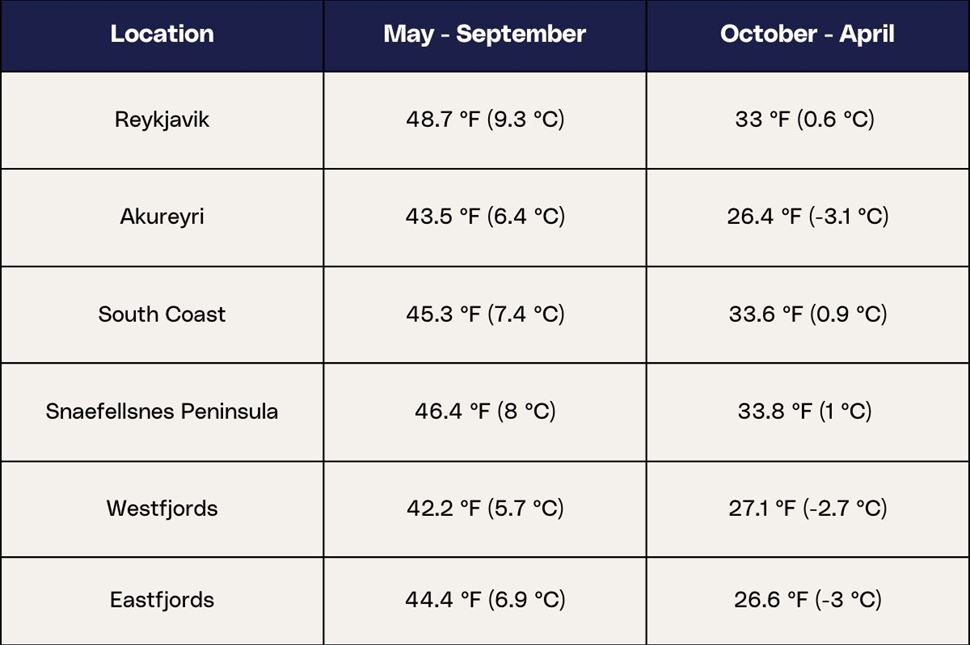
Average temperatures in Reykjavik and other regions. Source: en.climate-data.org
The climate in the world’s northernmost capital—Reykjavík, is warmer than that in other regions. While other coastal areas also benefit from the ocean’s currents, the capital’s location in the southwest is sheltered from colder northern winds. Reykjavik summer weather is gentle, with temperatures up to 13°C (55°F) in July. In winter, it stays around 1°C (34°F), with more rain but less snow than other areas. Being on the coast, it’s also windier than inland territory.
Weather in North Iceland: Akureyri in the North is colder than Reykjavík, with more snow in winter. Summers are cooler, with temperatures averaging 6.4°C (43.5°F). Winds are stronger, especially in coastal areas, and rainfall is moderate but more frequent than in capital.
South Coast Weather: Iceland’s South Coast is milder and wetter than the capital, with more rainfall, especially in places like Vík. Summer temperatures average 7.4°C (45.3°F). Winters can be colder, but snow is less common. Coastal winds can be very strong, particularly in winter.
Weather in Snaefellsnes Peninsula: Snaefellsnes Peninsula is colder than Reykjavík, especially in winter. Summer temperatures average 8°C (46.4°F), while winters hover around freezing. Winds are strong, with higher precipitation and snow, especially in winter.
Iceland Westfjords Weather: The West is similar to the capital region but can be slightly colder. Summers see temperatures around 8°C (46.4°F). Winters are colder, with occasional snow, and rain is frequent. Coastal winds make Westfjords windier than inland areas.
Eastfjords Weather: The winters are colder in Eastfjords of Iceland with more snow compared to the capital area. Summer temperatures average 6.9°C (44.4°F). Winds are less intense than in coastal regions, but precipitation is frequent, especially in winter. Snow can linger longer in higher elevations.
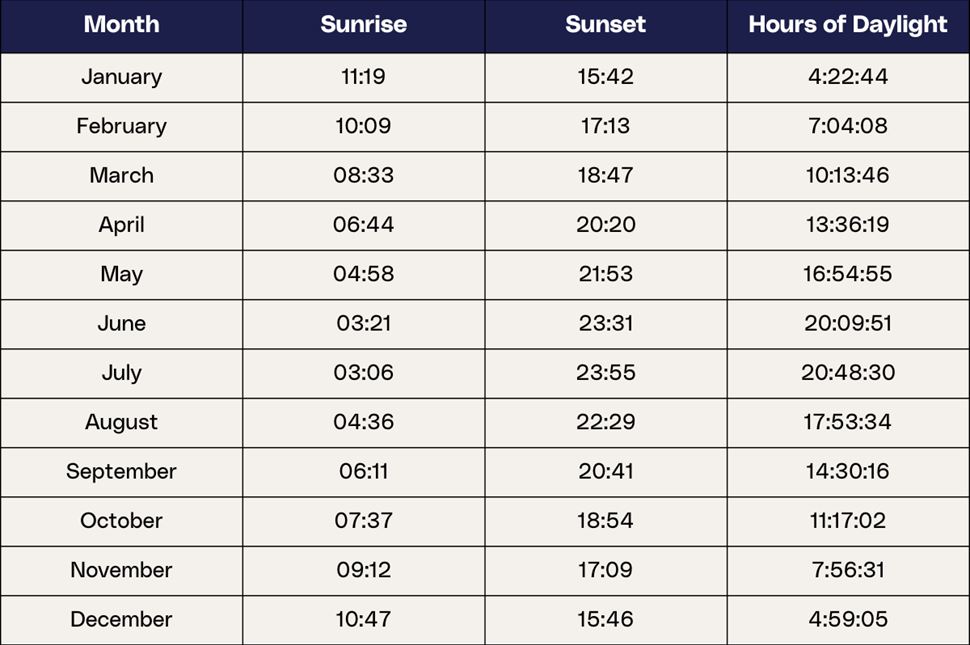
Sunrise and sunset hours in Iceland by month (first day). Source: www.timeanddate.com
Iceland time zone is the Greenwich Mean Time (GMT) without daylight savings, so clocks stay the same year-round. Daylight hours in Iceland vary a lot between seasons. In summer, particularly from May to July, Iceland experiences the midnight sun, resulting in nearly 24 hours of brightness. For example, in June, the sunrise is at 3:21 AM, and sunset is at 11:31 PM, giving more than 20 hours without darkness.
In contrast, daylight in winter is much shorter, with only 4–5 hours in December, making it perfect for viewing the northern lights. Endless daylight in summer and winter’s auroras make Iceland magical - discover both on our midnight-themed tours.
No, Iceland is not cold compared to other Scandinavian or Arctic countries. In summer, the temperature in Reykjavik averages 4 to 15 °C (39 to 59 °F). In wintertime, the degrees drop a bit below freezing at night and stay around 0°C (32 °F) during the day. However, the winds from the surrounding oceans make that cold feel much harsher but not as severe as in Norway or Finland.
Yes, it does get dark in Iceland, but not every day of the year. Because of the Midnight Sun phenomenon during summer, Icelanders have 20 hours of daylight for several weeks. Since the sun hovers near the horizon during this phenomenon, it creates an endless day with only a brief twilight for several hours.
The most pleasant months to travel to Iceland are during the summer, from late May through August. With better climate conditions, there are more travel opportunities. However, November is the most popular winter month for seeing the Northern Lights. You just have to be aware that you'll get little daylight during this period.
Summer in Iceland starts in late May or early June and lasts until late August. However, the weather doesn’t always match the calendar. In the past, Iceland’s weather was divided into “winter” and “summer” months, and sometimes the weather in the “summer” months can still feel chilly or wet.
Iceland is not cold in summer, but it’s definitely cooler compared to many other destinations. Daytime temperatures average 7 to 14°C (43 to 57°F), and nighttime temperatures drop to 4°C to 8°C (39°F to 46°F). While this weather is similar to those of other Nordic countries, strong winds can make the air feel a few degrees lower than the actual temperature. Make sure you are prepared for your trip with all the essentials packed.
The average overall summer temperature in Iceland is between 10-13 °C (50-55 °F), and the average winter temperature is around 0 °C (32 °F). However, these tendencies might vary depending on the region and time of day.
Iceland generally stays cool, with temperatures rarely reaching high levels. During the summer months, highs typically hover around 10-13°C (50-55°F). On occasion, temperatures can exceed 20°C (68°F), but this is uncommon. One of Reykjavik’s record highs is 25.7°C (78.26°F), set during a rare heat in 2008.
Iceland can get quite cold during winter, with temperatures typically ranging from around -3°C to 2°C (26°F to 36°F). The record cold temperature in Reykjavik occurred on January 30, 1971, when thermometers dropped to -19.7°C (3.4°F). Despite these extremes, Iceland’s coastal location and the Gulf Stream help keep its winter weather milder compared to other northern regions.
The hottest month in Iceland is July, with average temperatures ranging from 7°C to 14°C (43°F to 57°F). On rare occasions, temperatures can rise to 20°C (68°F). It’s also the driest month with the calmest winds.
December and January are Iceland's stormiest months. Severe snowstorms can cause flight cancellations and hazardous road conditions. For instance, a blizzard in December 2022 grounded flights at Keflavik Airport, and a storm in January 2024 led to flight delays and dangerous roads. It’s important to monitor search and rescue service alerts and road traffic information when traveling during these months.
January is usually the coldest month in Iceland and the peak of the winter season. During this time, temperatures in Reykjavik average around -3 to 3°C (26-37°F). In northern Iceland, temperatures can drop even further, reaching around -10 to -5°C (14-23°F).
In terms of climate, winter in Iceland typically begins around late November when temperatures drop and snow becomes more common. Interestingly, the first day of winter is celebrated on the first Thursday after October 24th, according to the ancient Norse calendar. While this is more of a traditional Icelandic holiday than a meteorological event, it marks the shift into the darker, colder months in the country.
The climate in Iceland is classified under the subpolar oceanic climate category, with fresh and short summers and mild winters. The Gulf Stream helps maintain moderate temperatures. However, the interaction between warm Atlantic and cold Arctic air leads to frequent weather changes and storminess, especially in the southern and western parts.
The small town of Vík í Mýrdal is Iceland's warmest location. Located on the tip of the South Coast, it is shielded from the cold winds that are common in the north. The average temperature in winter is 4°C (39°F), and in summer, it is 13°C (56°F).
No, Iceland does not observe daylight savings time. The country used to follow daylight savings time until 1968 when it decided to stay on Greenwich Mean Time (GMT) year-round. Since then, there have been no changes to the clocks, and Iceland has remained on GMT throughout the year.
Best Sellers